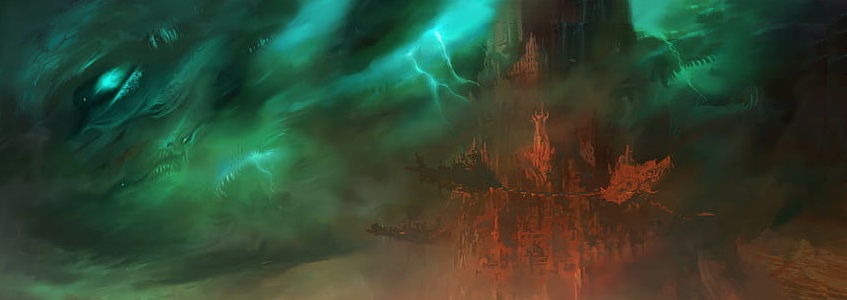
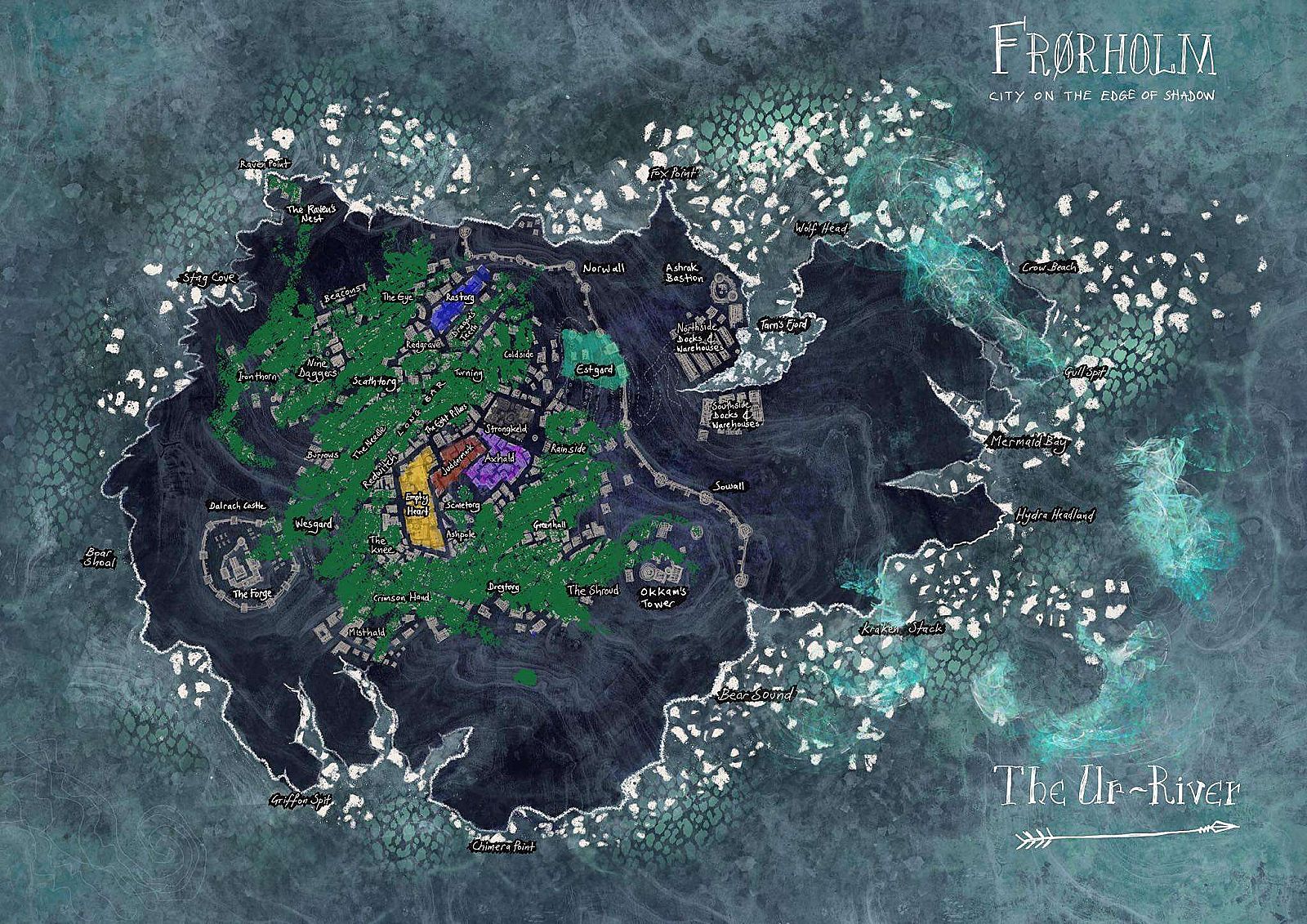
Turn 5 map of the island
Frørholm
The Isle of Mists
The Ur-River is thought by some to be the most ancient of all watercourses in the Mortal Realms. It is certainly among the most enigmatic. It is believed to have no headwaters and no outlet, instead crashing endlessly from one realm to the next, its course constantly shifting as it perpetually grinds a new path through the Realms. When it passes through Ulgu, the Realm of Shadow, it becomes even more treacherous and unpredictable than elsewhere.
As it winds through some of the thirteen kingdoms, the Ur-River becomes a wide and slow-moving waterway. In the perpetual gloom of the Shadow Realm, where it is never fully night or day, strange tides and unseen eddies in the river current seem to deliberately steer the unwary onto hazards in the water: smashed onto razor-sharp rocks hidden beneath its occluded surface; or into endless whirlpools down into crushing darkness.
Ulgu is known to be the domain of secrets and lies, illusion and menace. And here the Ur-River seems to whisper promises that will dissolve like ink in its endless waters
In the centre of a miles-wide stretch of the Ur-River there is an ice-covered rocky island, known as Frørholm. The river-banks of that mystical water-way are so far away that, even if the island was not wrapped in the swirling snow storm of a tethered Everwinter, it would not be possible to see the shore either side from a vantage-point on the island’s steep cliffs.
Cracked ice flows form along its rugged coastline. The Everwinter on the island freezes the river water that touches its shores, pushing ice ever-outwards. The slabs of ice furthest out break up as the warmer river water passes slowly under and around them. The chunks of ice float away down-stream, rapidly shrinking as they drift away.
The storm that enveloped the island concealed a city from the Age of Myth. It is thought the city was abandoned long ago, possibly when the Everwinter first came to Frorholm. The streets and buildings became inaccessible - encased in ice.
Frørholm was long avoided. Fishermen said it was cursed. Merchants saw it as unprofitable. Raiders thought it worthless. The dangerous river currents, unpredictable winds and crushing ice flows caused too great a risk to vessels and crew to be worth passing near. All passing river traffic gave the cold and rocky place a wide berth.
But something has changed.
The storm is suddenly different. Where it had blanketed the island in a vortex of spiralling white mists, the rocky shores can now be seen from the river. Glimpses of the outer edges of the city can sometimes be spied through eddies in the fog. The ancient legends about it have been remembered and now in the nearest outposts and strongholds along the banks of the Ur-River all the talk is about it.
Something has changed.
The City on the Edge of Shadow
The city of Frørholm lies like a slumbering beast, skeletal yet animated by some dark fire. Buildings can be seen deep within the ice that covers it like blackened bones. Mist pours from its tumbled gates like a dragon’s breath. And deep within its heart shines the faint yet entrapping glimmer of the Black Forge itself.
The buildings of Frørholm have upper stories made from weather-worn timber, and lower stories built from dark green stone. Many of them have tall wooden columns either-side of their main doorways and tiled roofs with steep eaves. The woodwork is ornately carved by highly skilled hands, with symbols representing serpentine beasts, ominous weather motifs such as gathering storm-clouds, spiralling winds, and towering, crashing waves, and uncharacteristically-crude depictions of rock creatures.
Each “ward” of the city is a distinct territory with (mostly) stone-paved roads dividing them. The narrow, zig-zag paths and backstreets within each ward are usually cobbled but some are just muddy dirt. Most wards are sprawling mazes of abandoned and broken buildings divided by the well-paved high roads, and act as both funnels for treasure-seekers and defensive positions. There are hundreds of doorways and arches, alleyways and cul-de-sacs that make fighting within the city dangerous and unpredictable, yet required to gain any measure of presence within its walls. As the Everwinter diminishes day by day, week by week, more wards become accessible and reveal their secrets.

The Feignlights
Eerie green “ribbons” or waves of light in the sky that seem to drift and move, fading and returning almost at random. They give the city a sickly green pallor in the half-light of Ulgu.
The North Coast
The Standing Stones
There were a thousand gigantic, but crudely-carved and lumpen stone statues of standing or sitting figures lining the entire coastline of Frorholm. Most were half buried in the ground, some were toppled-over and shattered, all of them were moss-covered and so weather-worn their features were hard to discern. But they have gone. The are no longer sightlessly watching the waters around the island.
Tarn’s Fjord
Slabs of floating ice fill the only natural deep-water harbour on the island. The fjord has high and steep cliff-walls for most of its curving length. The land either side of the south-western end is lower, and this is where the island's docks are - the shores on both sides are lined with stone quays and wooden warehouses.
Northside Docks and Warehouses
A strip of five large wooden warehouses with loading bays and scaffolds for pulleys at the front. The air is crisp and cold, carrying the strong smells of wood-smoke and fish. Behind the waterfront warehouses are the many ramshackle timber buildings of the shipyard, where the supplies for repairing ships were stored and the specialist craftsmen worked: sailmakers, carpenters, coopers, ship-smiths, ropemakers, and others.
Southside Docks and Warehouses
Southside is decidedly more shabby and run-down than Northside. It seems like it was built a long time before its neighbour. At its heart are two large wooden warehouses and two boathouses, interspaced with seedy taverns and inns.
- The Nine Thorns , inn. An old stone building with a red tarpaulin awning stretched over its entrance. The wooden sign over the door has a carved relief of a circle of twisted and barbed vines. This motif is repeated in the woodwork of the bar, the ceiling beams and the doors to the back rooms.
- The Cursed Rat , tavern. A low-ceilinged establishment, with a strong stench of salt and rum. The walls are adorned with rusty harpoons and fishing nets, and a case in the corner holds a large, preserved rat. The seven bedrooms upstairs are small and messy but warm and dry. They all have high ceilings and nautical decoration.
The Raven’s Nest
A short stone lighthouse on the north-western promontory, with a small group of low stone buildings clustered around it. All of the buildings were once white-washed, although there isn't much of it left, it is still just about visible and nowhere else on the island was.
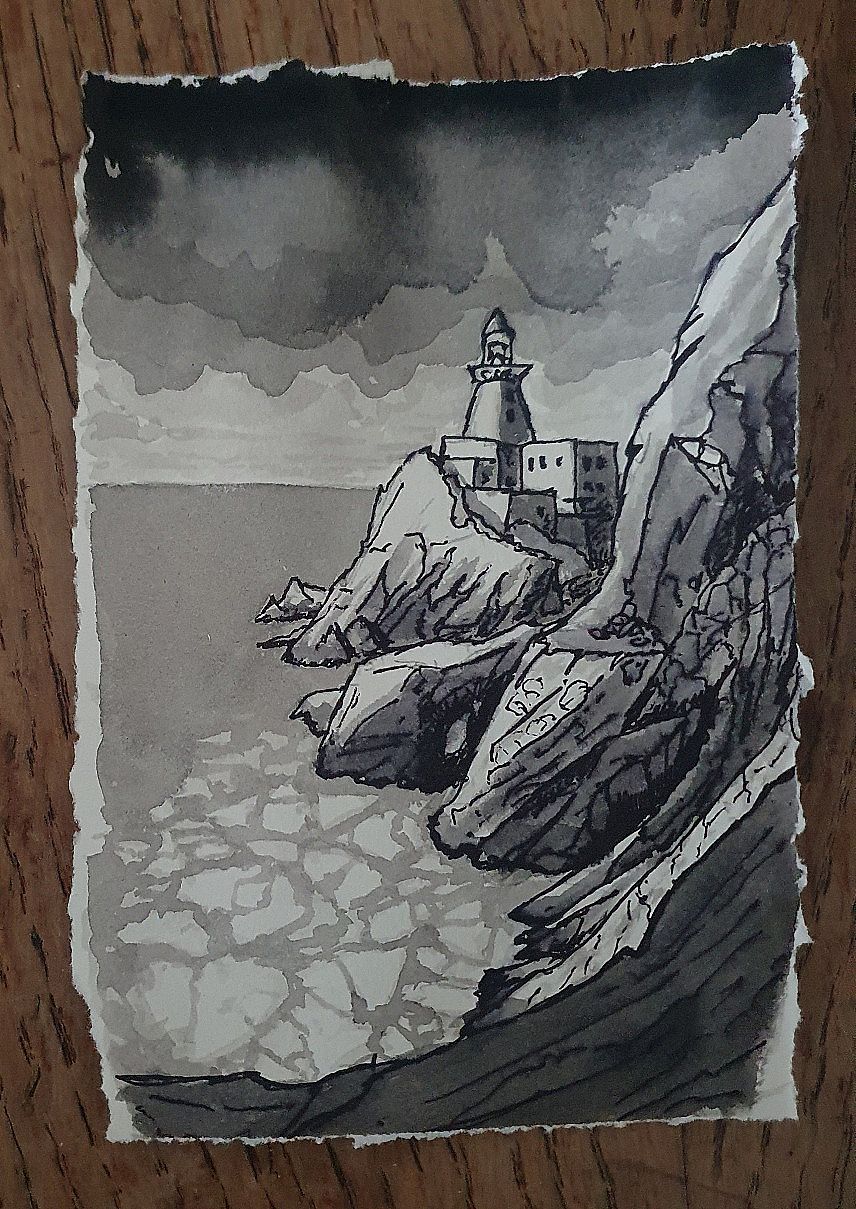
Ashrak Bastion
A squat and sturdy defensive "artillery" tower that overlooks the harbour in Tarn’s Fjord. The small two-story fort has circular sloping outer curtain-wall with two round towers on the northern and eastern faces. A semi-circular emplacement inside holds an “arcane artillery” device, that has been removed but it used to point at the entrance to the harbour.
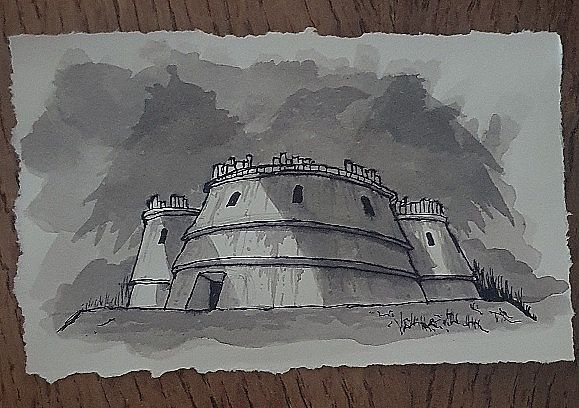
Lowtown
Norwall
The northern half of the city wall stretches between the northern coast, with which it runs parallel for a while before turning south and running unbroken to the main city gate, Estgard. It is broad and high, casting shadows over the dead trees and the steep slopes below. Icicles hang from the battlements like sharp, glistening teeth. A layer of thick frost covers everything.
Sowall
The southern half of the city wall runs from Estgard, the main city gate, round the foot of Eidolon Hill and terminates on the rugged cliffs of the southern coast. Mausoleums, crypts and graves line the area just outside the southern half of the city wall. Beyond them are the traces of much older barrows. A lone raven perched on a nearby roof watches with beady eyes.
Estgard
A stone-paved road turns sharply left and right as it winds up the slope to the main gatehouse between the harbour and the city. The gutters either side of the road stream with meltwater. The square towers that frame the open and broken gate loom menacingly in the darkness, the dark green stonework makes them hard to see in any detail unless viewed from very near. But even so the symbol of a crow with its wings outstretched and a sword in its talons can be clearly seen, carved into the stone above the gate. Through the gates the switchback road continues up the hill, toward Coldside and Rainside, it is lined on the left by an embankment topped with empty plinths that probably once had statues on them.
- The plinths did in fact have statues on them once; they were all broken up and the parts are buried in the ground nearby.
- Inside the gatehouse, on either side of the stone archway are cavernous chambers. The air is thick with the scent of damp earth and rot in both, while eerie shadows seem to be disconnected from light sources or occupants. In the left chamber, rusted chains hang in alcoves along one wall, behind jagged iron bars. In the right chamber a stone spiral-staircase ascends to the rampart wall-walks, flanked by large bas-relief carvings depicting battles between strange, almost insubstantial figures and fierce deep-sea beasts.
Coldside
Most of this ward is a large public square, where the ground is muddy but frozen. The irregularly shaped open space was occasionally used for fairs and festivals, but most often livestock markets. Many of the buildings surrounding it were connected to the market - livery stables, a farrier, a blacksmith, an abattoir, a butcher, etc.
- On the north side a tall building has a gaping hole in one side, apparently ripped apart from the inside. Snow has gathered in the exposed rooms; it might have been the home of a blackpowder maker.
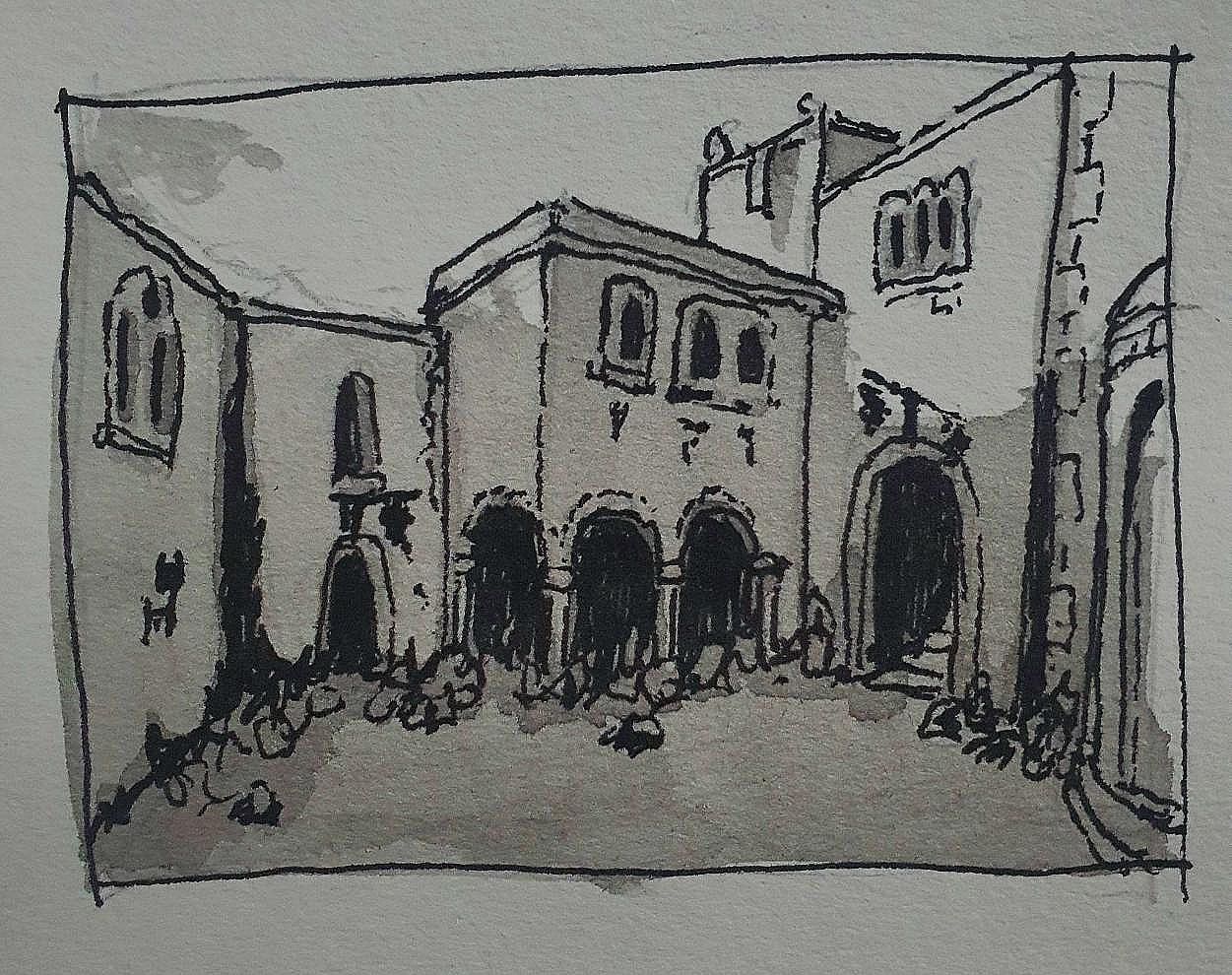
Rainside
A chance alignment of geography and buildings has created a micro-climate in this ward that turns snow into sleet and thick fog that reduces visibility to just a few feet. The western edge of the ward is marked by a public square with a broken fountain in the centre. This area was always treated as neither Rainside nor Strongkeld.
- The workshops of wheelwrights, cobblers, ropemakers and undertakers rub shoulders in close-packed alleys. Tools and materials litter the ground inside and between them.
- A narrow and tall shop, with a sign missing a few letters hanging above the door. The inside of the shop is cold and damp, with burned-down candles casting in mounts on the walls. Hanging from the rafters, is a collection of mouldy fur-lined cloaks and thick woollen scarves in a variety of drab colours.
Strongkeld
The heart of this ward is a large manor house with its own walled garden and well. Snow and ice cover exposed surfaces, icicles like swords hang menacingly from roof-eaves. The eastern edge of the ward is marked by a public square with a broken fountain in the centre. This area was always treated as neither Strongkeld nor Rainside.
- An unsavoury tavern - The Damned Star - sits next to a stinking open culvert that was apparently mid-repair when the city was frozen.
- At the end of a cobbled lane is the Shrine of Saint Tress . The statue of the saint stands in the centre of a shabby hut, her eyes painted with an eerie blue. Cold wind whistles through the cracked stained glass windows. A faint whispering seems to come from the base of the statue.
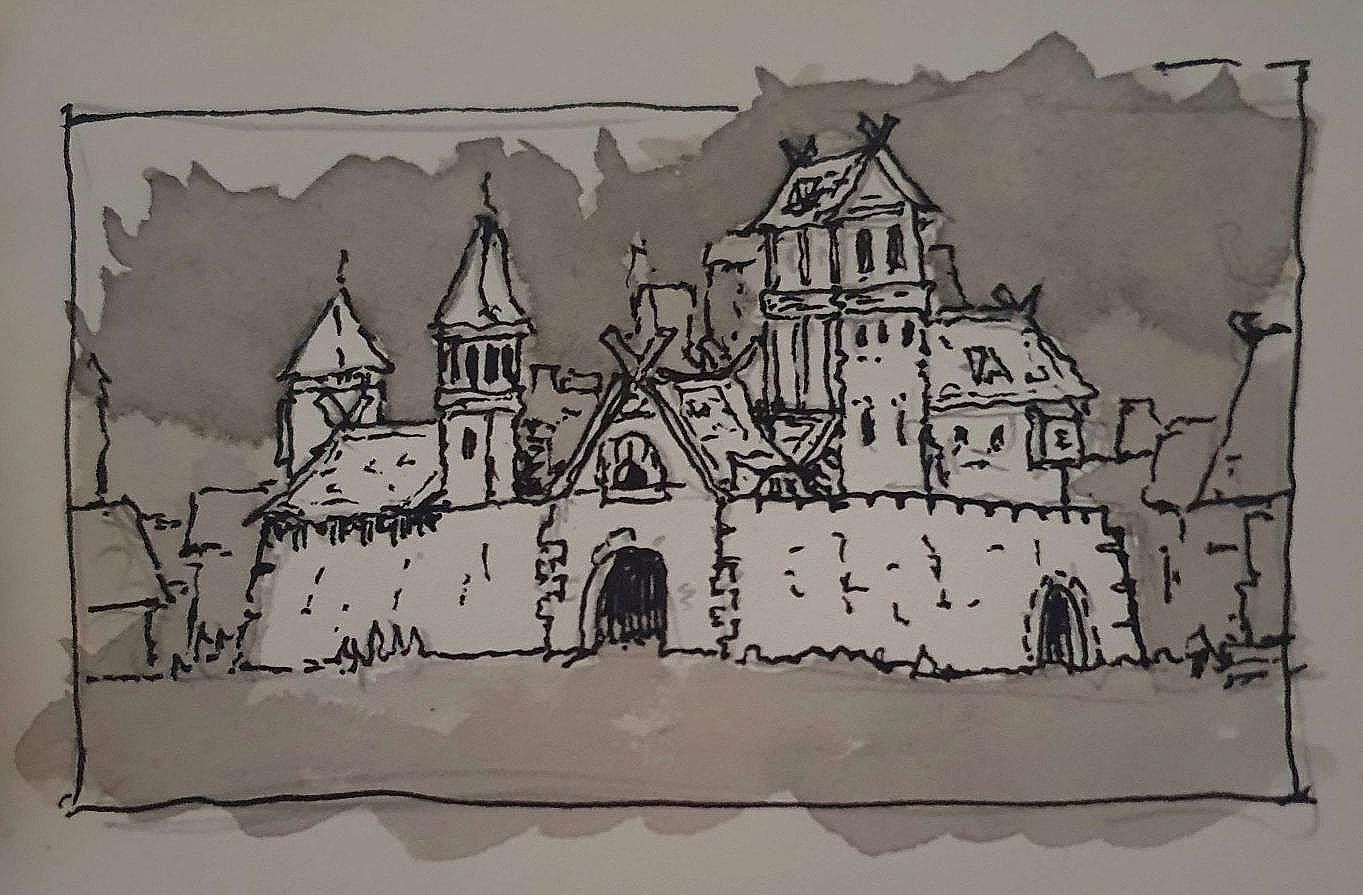
Rastorg
An oval racing arena with two long straights and two very tight corners around a central line of columns. The arena is made of dark stone, the wooden stands inside it that surround the track are only about 6 feet above the arena floor, so spectators would have been very close to the action.
- Inside the arena, at the north-eastern end, there is a row of six brightly painted wooden starting stalls, staggered to equalise the distance of one circuit. Each one wide enough for a chariot pulled by four beasts. The front of each stall is enclosed by a spring-loaded gate, so that all six can be opened at once by a single operator.
- A printmaker's studio in a small wooden building nestled between abandoned storefronts. Ink and paper mixed into a pulp, and frozen by the winter temperatures, covers the floor. Illuminated prints hanging on the walls. The printmaker seems to have been interrupted while carving an intricate woodblock; the tools and wood-shavings are still scattered on the workbench around it.
- The Shrouded Mare , inn. A large metal horse’s head hangs above the entrance to the bar, its glass eyes glinting eerily from beneath a leather hood.
- The Seven Bells , inn. The walls of the common room are decorated with chariot racing trophies and memorabilia. Wheels, tack and harness, engraved cups and shield-shaped plaques, and a handful of spears and whips, have been attached to the stonework with care and reverence. The scattered tables and chairs are surrounded by slips of paper with numbers hand-written on them.
Dragon’s Teeth
A dark and foreboding area with angular, jagged stone walls rising up on either side of every path. The eaves and gables of every roof are home to crows that will angrily caw at anyone who walks the stone flags, crunching the ice below them.
- The Apothecary is a small, one-story building with a thatched roof and a single wooden door. The air inside is laced with the smell of herbs and spices, partially masked by a hint of wood smoke. A large glass jar filled with murky-yellow liquid sits atop the counter, next to a mortar and pestle and several pouches of dried herbs.
- The Crooked Rider, inn. A thatched three-story building, the top two stories have timber-framed walls that lean slightly to one side. The doors and windows are boarded up, and the only entrance is a wooden door that creaks and groans with the slightest gust of wind.
Turning
This ward appears to have once been a centre of learning with grand stone buildings facing inward toward a long L-shaped courtyard. Footsteps are muffled by drifting snow, but the slightest sounds echo off the walls either side. Restless shadows gather between the abandoned buildings.
- A small bookshop with a single window that looks out over the empty courtyard. The smell of old parchment lingers in the air, mixed with the smell of something sour from the fireplace. Resting on a worn wooden stool near the door is a thick tome. A well-preserved ancient manuscript lies on the counter under a small hand-written sign that is no longer legible.
- A Book-binder's workshop in a small, single-story building made of stone. The symbol of a crow with its wings spread wide and a sword in its claws has been carved into the stone above the door. The air is filled with the musty, earthy smell of old paper and leather. A small forge burns in the corner, casting flickering shadows across the room. On the workbench, a large leather-bound tome sits half-finished, the carefully stitched binding still has a threaded heavy needle embedded halfway through it.
- The Grasping Bones , tavern. Much larger tavern than it appears from the outside, with winding hallways and hidden alcoves. Most of the furnishings, including the tables and chairs downstairs and the beds upstairs, have carvings of skeletal hands in the woodwork.
The Eye
A public plaza, named for the shape of the open space, surrounded by empty buildings with blackened windows lined with ice. Howling winter winds echo round the plaza. A broken fountain stands in the centre, with a layer of snow and ice covering its once-proud statues.
- Grordo’s , large inn. The large common room is filled with large tables and lots of chairs, and the kitchen in the back is many times larger than the drink cellar.
- A locksmith's in a small two-story building on a corner, with a sign of a large gold key hung above the door. The windows are boarded up with planks of wood. The building holds tightly onto the secrets of its former occupants: A rusted metal padlock is attached to the door, though it appears to have been forced some time ago.
Redgrave
A cluster of narrow cobblestone alleyways with two and three-story buildings crowding the roadsides. A thick fog hangs in the air, clinging to the walls and windows of the buildings, making it hard to see beyond a few feet. The buildings appear to be dilapidated and some have wooden boards covering windows, while others have large cracks and holes in the walls.
- A cartwright in a rickety wooden building, with splintered planks and holes in the roof. The building casts eerie shadows on the surrounding snow. A howling wind echoes through the empty streets. Inside, a rusted cartwheel leans against a wall, creaking and swaying as if pushed by a phantom breeze.
- Greysworn's Bakery . Three stories high, looming over a small square. The windows are boarded up, but the smell of stale bread lingers in the air. Frost clings to the cobblestone street, reflecting the dim light. A small, wooden sign creaks in the wind above the door, reading "Closed Until Further Notice."
- The tower of a windmill stands slightly taller than the surrounding rooftops, its dark-green stone walls imposing against the twilight sky. A piercing cold wind blows from the north, causing the ragged sails to sway and rattle. A raven caws loudly from within the mill, a warning to stay away?
- A strange, spidery pattern is engraved round the door frame of a tailor’s shop. All of the many rolls of fabric inside are rotted and mildewed. A hole in the roof let the weather in and everything inside was soaked, ruined.
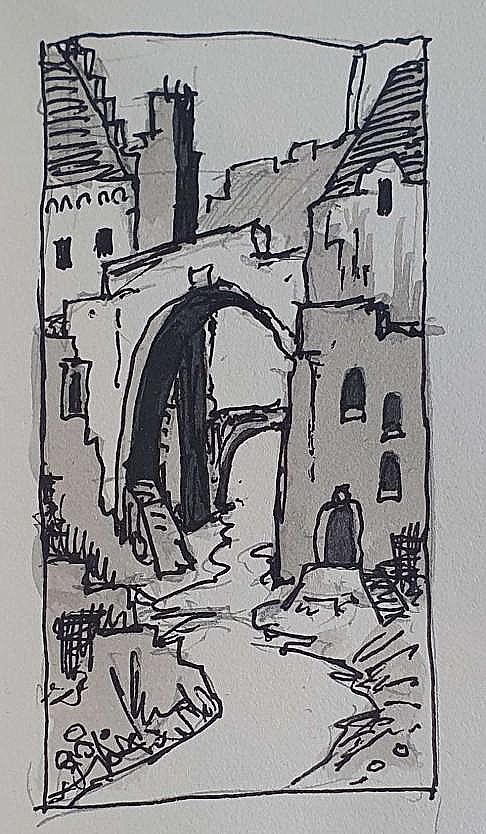
Juddermark
A maze of narrow streets and crooked buildings made of expertly-hewn stone. An icy mist hangs in the air, reflecting the faint light. The long-gone vendors fled without pausing to pack up their wares. A three-story clock-tower stands out, with gears and steam pipes jutting from the roof, the broken tower leans precariously, the clock’s hands frozen in time when the city came to a standstill.
- A workshop's windows are shattered, leaving the interior exposed to the outside elements; snow is piled up inside the empty halls. A partially completed statue of an angel with tattered but beautifully carved wings stands in the middle of the room, the lower half is still a block of rough-cut green stone, as if the sculptor had been interrupted while discovering a figure that was hidden inside the stone block. A thick layer of dust covers it, and the many other half-finished statues, and the tools left lying about.
- The door to a fletcher's workshop sits open, revealing a spacious single room with high ceilings and blanketed in dust. The twilight seeps through the shuttered windows, revealing rows of empty wooden racks, stripped of crossbow bolts and arrows. on one side of the room, a half-broken workbench. A faded target is painted on the wood-panelled wall opposite, studded with arrow holes in from long-forgotten archers.

Scaltorg
Once a bustling marketplace that was the main merchant’s square. There is a large frozen fountain in the centre, ringed by statues of “gods” that have all been defaced or broken. Between the fountain and the statues there is a wide space filled with wooden traders' stalls with canvas canopies. The icy cobbled streets and ginnels are lined with empty stalls, overturned carts, scattered boxes and bags - the traders’ wares are long gone. The wind whispers through the ragged canvas covers like the voices of years-dead merchants, still haggling with years-dead customers.
The statues represented:
- The warrior
- The provider
- The healer
- The sage
- The teacher
- The maker
- The taker
- The carrier
Axhald
A labyrinthine network of abandoned workshops and ginnels. The narrow cobblestone pathways are flanked by three and four-story buildings. Creaking shutters swing on cold gusts of wind.
- A large, intricately carved wooden bear statue stands guard at the threshold of the door to a carpenter’s workshop. The space is cluttered with tools, half-finished projects, and scraps of wood - some partly carved into animal shapes. A dusty shaft of dim twilight filters in through the small, high-set glass window.
- A silversmith's workshop in a sturdy stone building with a sloping roof and narrow windows. The small forge is cold. The precisely-crafted tools are left untouched on the workbench. The small cabinets, that once displayed a collection of delicate silver rings, unusual trinkets, filigree bracelets that caught the dim light just-so, are empty.
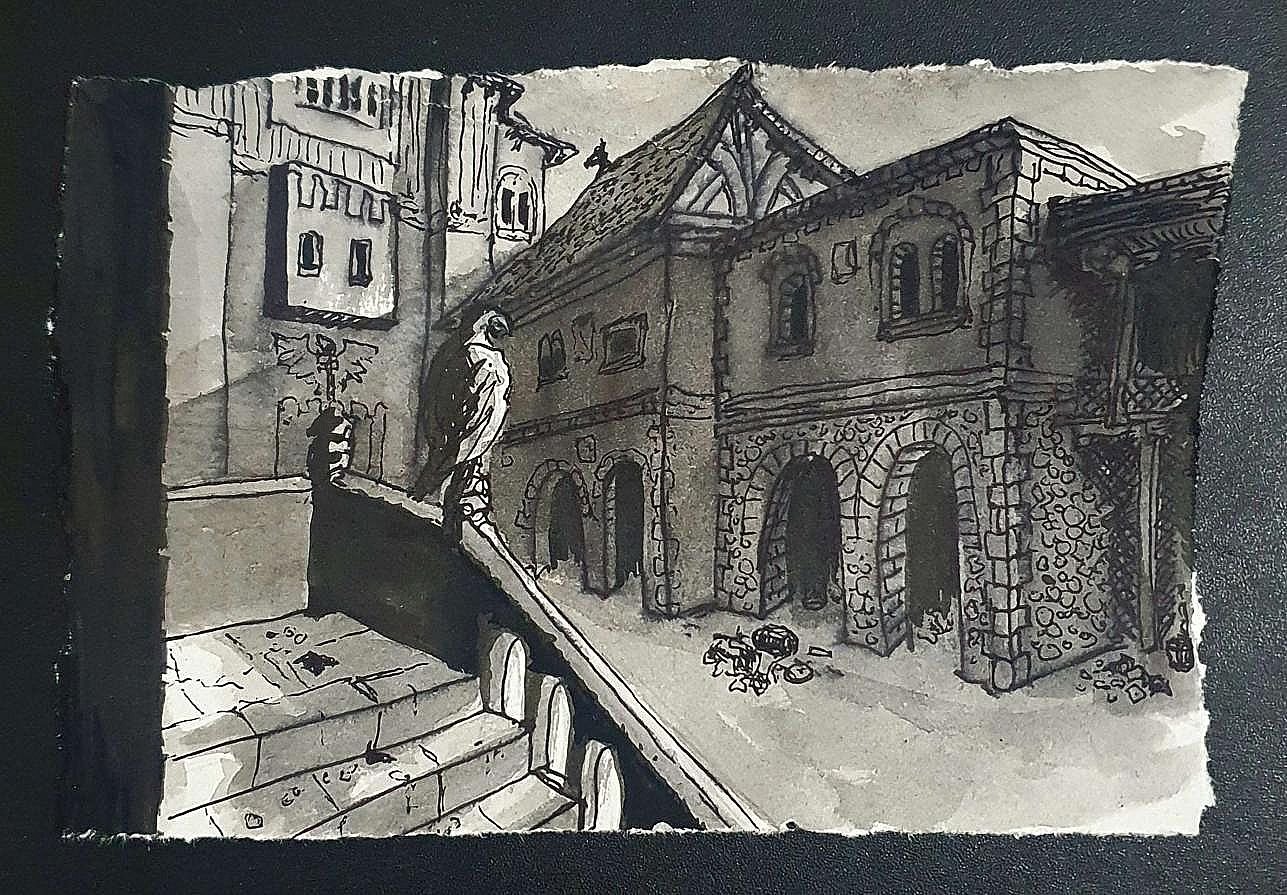
The Centre
Scathtorg
A tall, ring-shaped, stone fighting arena. The topmost level is roofed with timbers but the central arena is open to the sky. The lowest level of the stadium is 20 feet above the arena floor and the dividing wall is lined with spikes that point downward, into the arena.
- The Bestigor's Head , tavern. Suspended from the rafters is a massive stuffed bull's head, adorned with dozens of gold coins and trinkets.
- The Drakeseer , tavern. A grand establishment with high ceilings and intricate chandeliers fashioned from dragon's claws. There is a large open grill in the centre of the main room. Mounted on the walls around it are the heads and claws of various types of reptilian beasts, giving the tavern its name.
- Ignax's Keys , tavern. A massive ancient key serves as the centrepiece of the room hanging above the bar. The key is engraved with fine text that tells a story that implies it belonged to the tavern's eponymous godbeast. It has dozens of smaller keys dangling from its ring.
- The Crystal Theatre was a grand building with ornately carved wooden columns either side of the front doors. Inside are soaring ceilings with the wreckage of chandeliers. An enormous tapestry of the town dominates the curtains of stage, and in the back-stage spaces flanking the mouldering drapery, there are several dark blue leather-bound books of scripts, the spine of each is embossed with the gold-leafed silhouette of an arcane symbol.
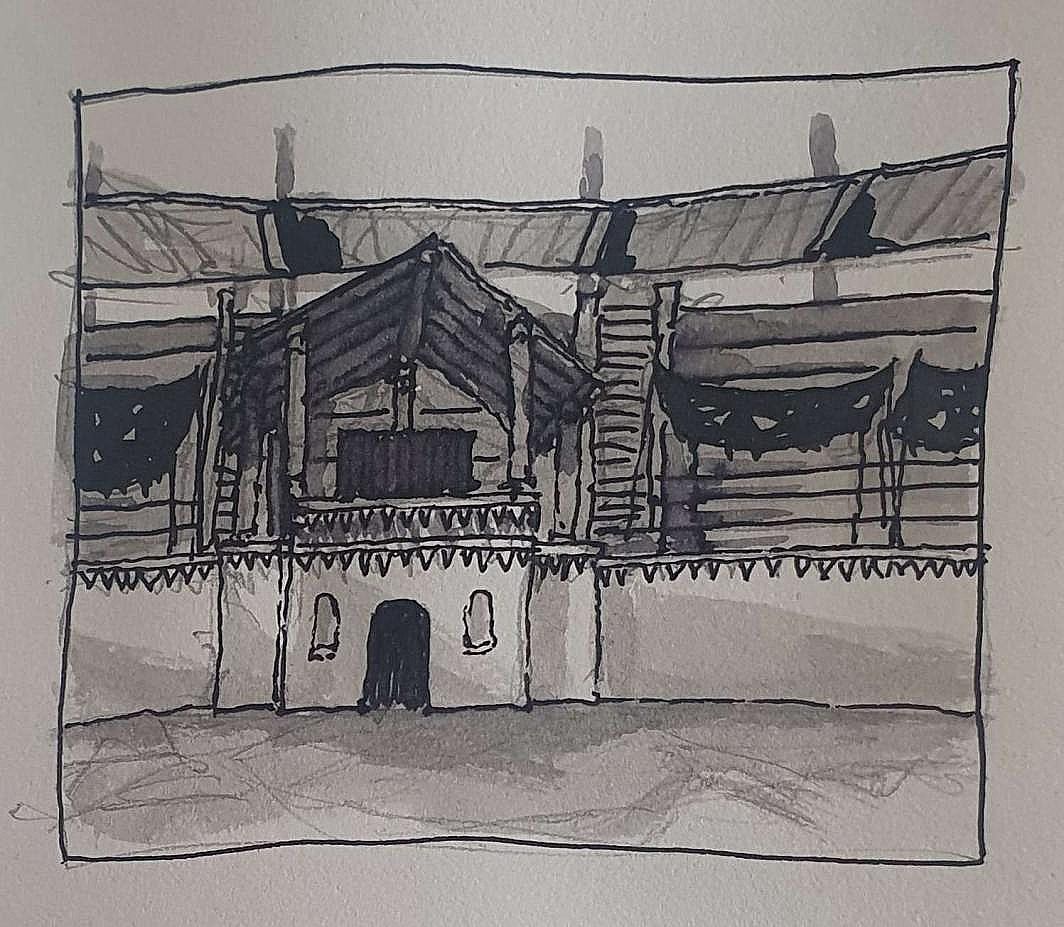 Nine Daggers
Nine Daggers
Narrow winding passageways flanked by tall buildings, the crooked walls seeming to bend in on themselves. The crumbling, stained buildings loom overhead, forming deeper shadows over the littered cobblestones. The icy air is filled with the sound of dripping water and the faintest scent of something rank.
- Crucible of Khaine . The remains of a ruined temple, with a gilded statue of Khaine that leans over sideways a little, is tucked-away in a courtyard. The faint whispering of unseen spirits fills the temple, a haunting welcome to the God of Murder's abandoned domain.
- The Mortuary . A harsh-looking, angular building constructed from dressed-stone blocks, with a single arched entrance and no windows. Crows caw and flap their wings on the rooftop, as if vying for dominance over the building. The wooden doors are barred from the inside, but the smell of embalming chemicals is overpowering.
- The Absent Blade . A large public plaza, triangular in shape, with cobblestone paths around the edges. The surrounding buildings loom tall around it, their narrow windows boarded-up and their roofs sagging or caving in. The air is quiet and still, save for the occasional gust of wintry wind. A statue of a knight on horseback stands in the centre, her armour angular and razor-sharp, her sword pointed to the sky as if leading the way forward.
- Standing at the centre of a graveyard surrounded by a rusted iron fence, a large mausoleum with broken stained-glass windows can be seen through chance gaps in thick coiling mist.
Long Bar
A stone-paved road that cuts through the city from north-east to south-west. Snow covers the cracked flagstones, icy winds howl along its length, that sting lungs and make clouds of visible breath race away. Dalrach Castle can be seen, even from the far end, a black silhouette against the dark sky.
Beacons
A long row of shabby buildings stands silently as a sombre reminder of better times. The structures look as though they might crumble at any moment. The icy wind causes the wooden shutters to clatter against the walls, creating an eerie background noise. The ward’s secrets are concealed by writhing shadows.
- A cooper’s workshop is tucked round a corner in a dead-end alley. Dozens of wooden barrels of various sizes and proportions are stacked along the walls outside. Tools, unassembled wooden staves and iron hoops are scattered around the floor inside, as if the place had been turned upside-down while being searched for something.
- The Idle Gnarlmaw , inn. Once well known as a dangerous grog shop. The place was infamous for the shady individuals who frequented it. It was blamed as the source for most of the town’s nefarious dealings, and the clientele were proud of it.
The Eight Pillars
In the middle of the ward named after them, a double-line of eight towering stone columns stand in a long, frost-covered plaza. Icicles hang from the carvings: hundreds of beasts of all kinds that spiral upwards and around the pillars. Each of them includes a crow, with its wings outstretched and a sword in its talons, etched into the stone. The shops and houses here all seem to be connected to Turning: the neighbouring ward.
- A printmaker's shop in a small building with a sign that reads, "Inkpressive". A sense of loss hangs in the air, cobwebs cling to the shelves and dust covers the empty printing press. Within the shop, there is a desk covered in parchment, and a half finished, but carefully etched, design on a metal plate.
- The auction house. This was once a grand, five-story building with dark wooden panelling and tall, arched windows. Rows of bookshelves reached the ceiling, and a massive oak lectern dominated one end of the main auction room. The windows were broken a long time ago so the old books and rolled parchments are musty and damp. Some of the shelves have collapsed and scattered their contents across the floor. The fallen books are covered in small mushrooms.
- A small sign above a storefront reveals this to be a book-binders workshop. Inside there are many specialist tools, along with quantities of fine soft leather, paper, strong thread, glue and ink. But the tools are rusted and the supplies are damp and covered in strange mushrooms.
Empty Heart
This might have been a busy ward. The workshops and stores look as though they were welcoming and well loved. Now a lantern gutters in the wind, casting dancing shadows on the walls behind it, but the shadows continue to dance even in the moments when the wind abates.
- The Aviary is a large domed building with ornate carvings of ravens and magpies sculpted into its stone exterior. The wind whistles through a hundred empty cages. The building is dark and has the appearance of being hunched forward. A small sign that reads: "Closed for the Season".
- Inside the large stone-built brewery the sound of water running can be faintly heard, from the underground stream that once supplied it.
- The Oast House looms in the darkness, a squat brick building that looks more like a fortress than a brewery. The inside smells of malted grains and hops. In the corner, workers once carefully stirred piles smoking hops with long wooden paddles that lay where they were dropped. The large wooden vats are home to a colony of rats.
- Beneath a house called the Wailing Caverns is a dark and damp tunnel system dug into the earth below the ward, with winding and narrow passages. The sound of dripping water echoes throughout the tunnels, making it difficult to pinpoint the source of any other noise. A trio of ancient statues of indeterminate origin stands watch over the entrance, their outstretched arms blocking the path. A small pile of bones next to a rusted dagger, and a pile of discarded pouches and money bags hint at the occupation of the former inhabitants.

The Knee
The steep streets are lined with stone buildings; tower-like monoliths that reach up into the darkened sky. Deep quiet lends an atmosphere of sinister foreboding.
- The Butcher's Den stands in a desolate corner of the market square, its wooden sign creaking in the bitter chill. The windows are grimy, and it's difficult to see inside the darkened shop. A strong metallic scent hangs heavy in the air, hinting at the building's grisly purpose.
- A Weaver's house stands three stories tall, with a decaying roof that makes it look like it's hunching over. Broken looms sit behind the boarded-up windows. An old, faded sign reading "Spindles" hangs above the door.
- An abandoned tower looms over a small square, its stone façade weathered and worn. Cold wind whistles through the empty windows and spins on the floor inside. Rumours say it is cursed and haunted by the ghost of a long-dead sorcerer. A sign above the door depicts the symbol of the tower's proprietor, a serpent coiled around a staff.
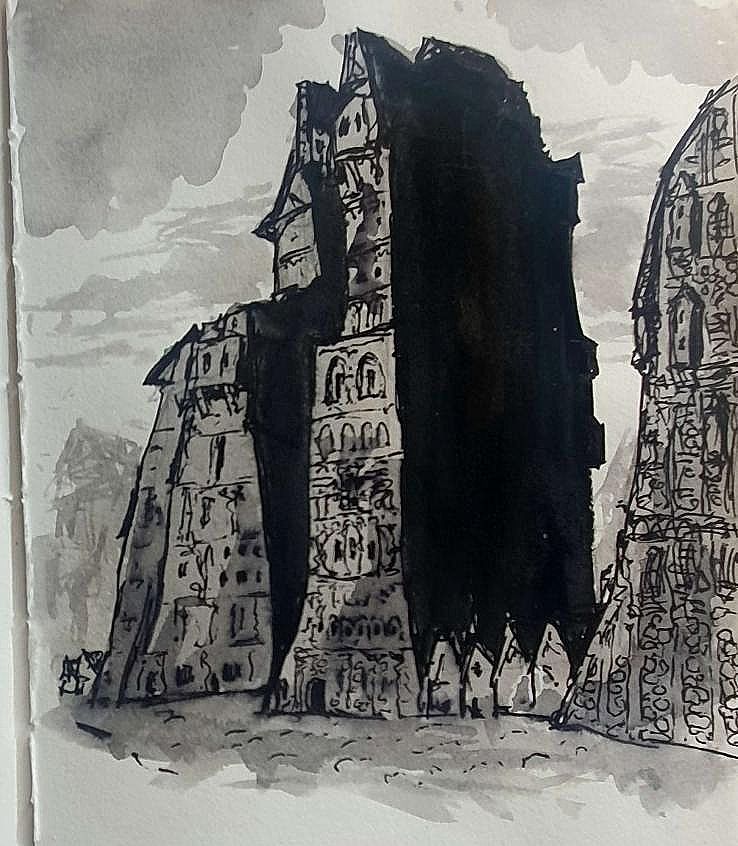
Ashpole
The ornately carved woodwork that adorns the upper stories of the stone houses is weather-worn and has peeling paint, but the word BETRAYED, painted on a stone wall, looks fresh.
- The Pale Mist Inn . A dilapidated two-story inn, its whitewashed walls now grey with age and neglect. A thin layer of fog creeps in through the cracks in the boarded-up windows and floors, casting an eerie pallor. The inn's namesake seems to linger in the air, mingling with the smell of burning wood from the fireplace in the common room.
- The Locksmith's shop is a squat stone building, pockmarked with age and neglect. Heavy wooden boards cover the windows and door, giving the space an air of mystery and secrecy. A single lantern, rusty and broken, hangs above the shop's sign: ' Thornbriar and Sons, Locksmiths '. Inside piles of papers and small tools cover a wooden table.
- A Dyer's Shop stands three-stories high with a steep sloping roof and shuttered windows that give no hint of what lies within. A thick layer of dust coats the furniture inside, and the room is filled with old oak barrels of dried out dyes in numerous colours. The walls and shelves are lined with the remains of half-dyed fabrics, including some intricate but rotted draperies. A dusty journal on a desk at the back details hundreds of dye recipes.
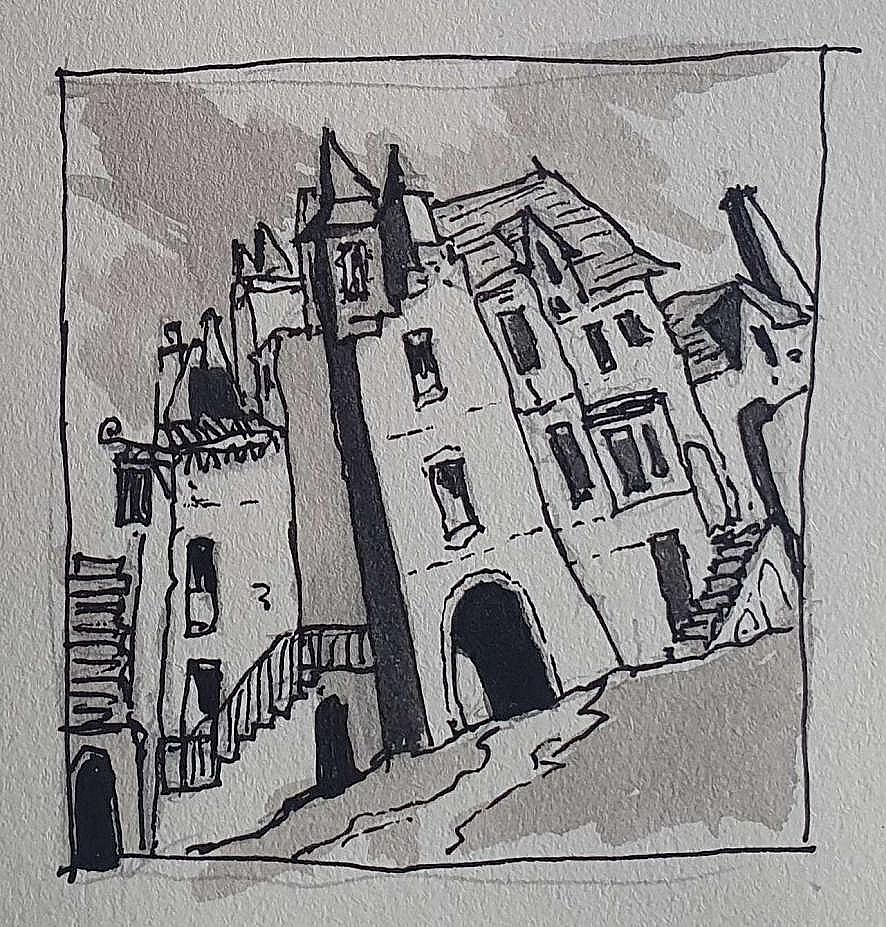
Greenhall
Like much of Frorholm, Greenhall is a sprawling maze of empty and broken buildings. There is a large public space at the eastern end that was used for duels as none of the surrounding buildings have windows that overlook it. A cold and bitter wind howls through the streets and alleys, sending frozen debris cascading across icy flagstones.
- An abandoned Exorcist's Shop in a dilapidated, two-story building with creaky, frost-patterned windows. In the dim light, tendrils of ice creep up the walls. The heavy scent of old books mixed with a hint of incense remains in the air. A lone, tattered book sits open on a table in the centre of the room, next to a burned out candle.
- The Golden Gryph-hound , inn. A large building of dark stone, with what might have been a beautifully kept garden in the courtyard behind it. In the expansive entrance hallway the inn's most unique feature is a gigantic crystal chandelier hanging from the ceiling that reflects rainbows all around the room, even in the dark.
- The Brass Rat , tavern. A ramshackle three-storey structure, with crooked timbers and uneven shingles that give it a perilous look. The air inside is thick with the smells of spices, exotic perfumes and rotten meat. Above the door, a brass plaque depicting a dead rodent is nailed to the timbers.
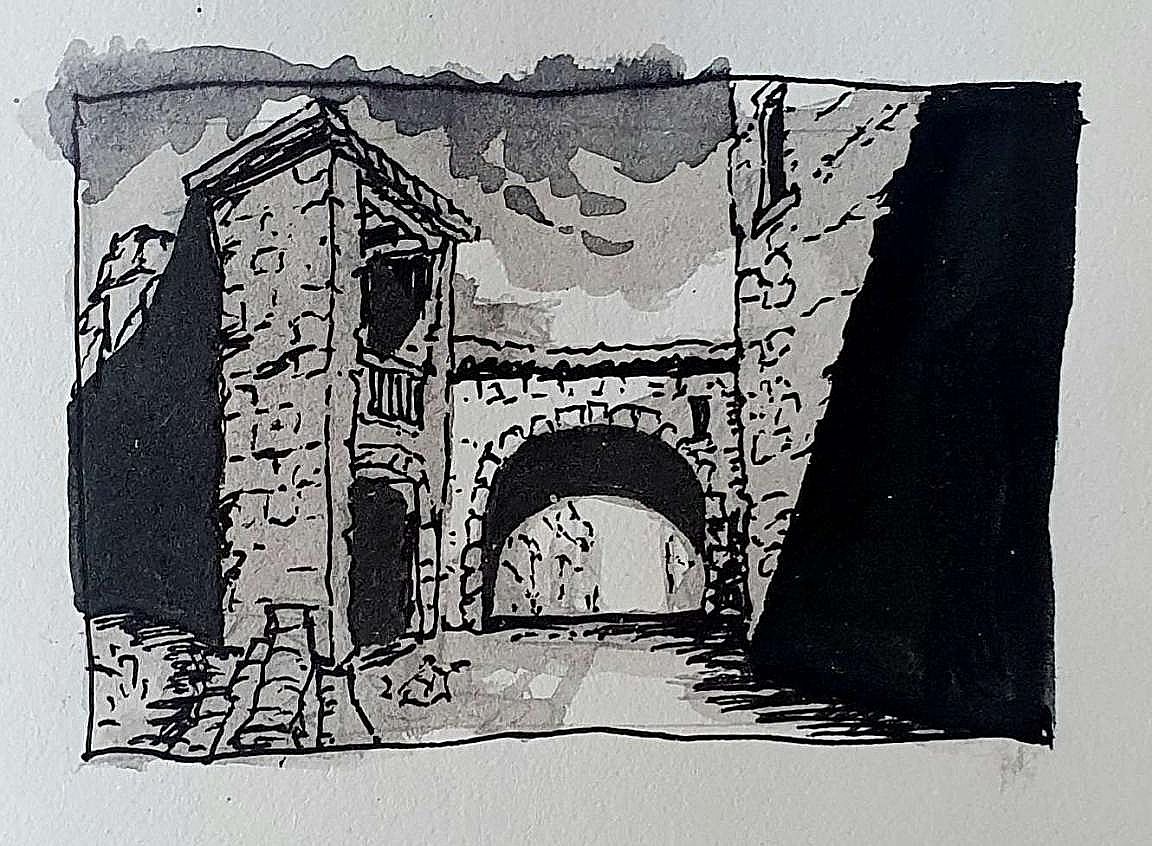
Okkam’s Tower (Battle Site 2)
Okkam’s Tower was a wizard’s stronghold. It is built in an architectural style unlike the rest of the city. It stands on the top of Eidolon Hill, the second highest peak on the island. It is surrounded by a cluster of smaller buildings, around the edge of the flat summit, that quartered the wizard’s staff and retainers. These houses face inward to a stone-flagged plaza and have no windows in the outward walls.
The Tower itself stands over twice the height of its tallest neighbours. It is solidly built, of grey stone punctuated by small narrow windows with the symbol of a crow with its wings outstretched and a sword in its talons etched into the stonework. There is a higgledy-piggledy collection of half-timbered bartizans and brattices, protruding asymmetrically from all sides.
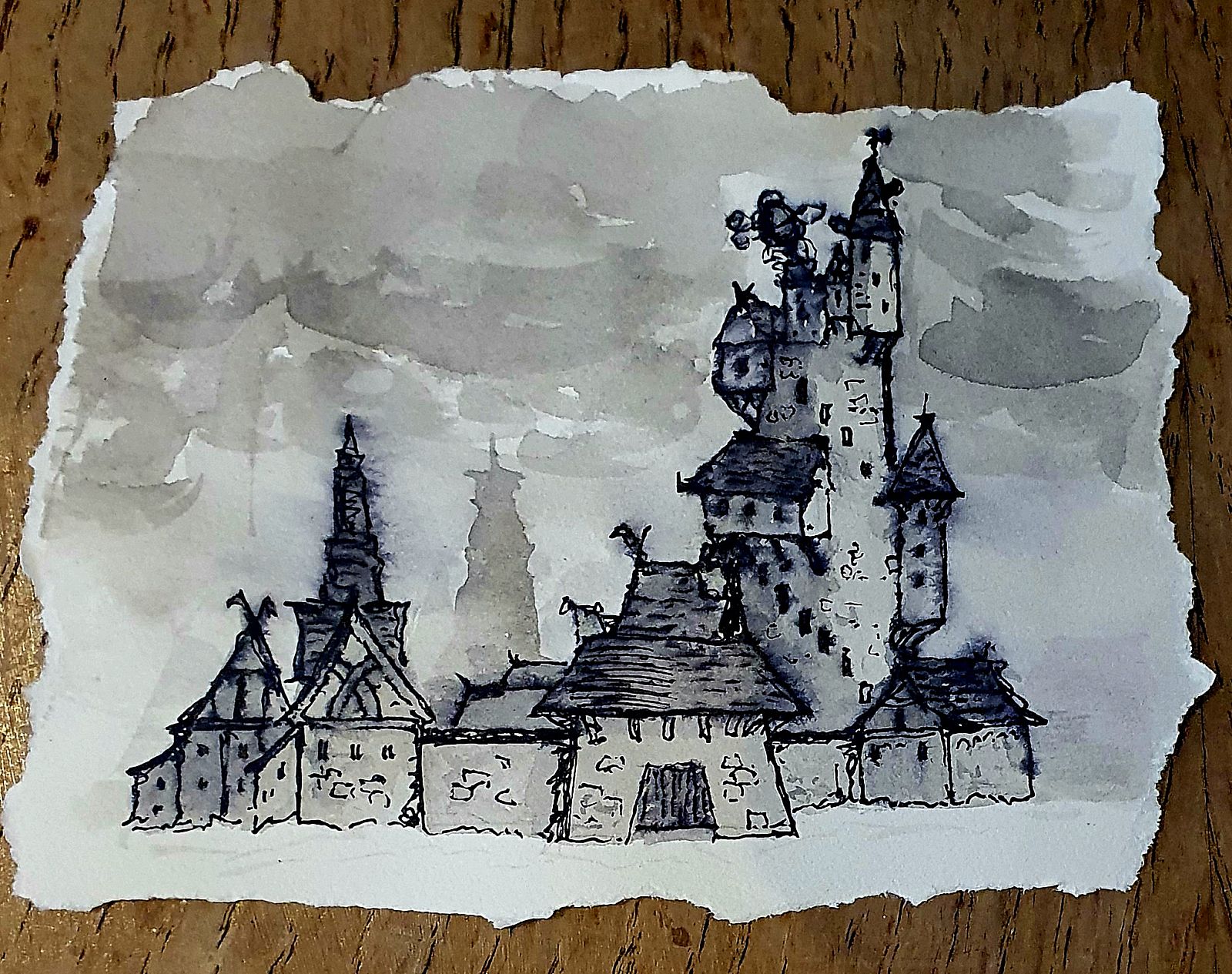
Hightown
Crimson Hand
Many windows are broken, doors hang creakily from rusted hinges. The narrow streets of the small ward are littered with broken furniture and the signs of fighting that ended long ago but left no-one to clear the debris. There are red-painted hand prints on almost every corner of the ward.
- Varghulf's End , inn. A wretched hive of scum and villainy. A dilapidated stone structure, with rotting shingles and a sagging signpost. The whole place gives off an overpowering stench of stale ale and unwashed bodies. In the centre of the room stands a massive stone hearth, surrounded by wrought-iron cauldrons and empty roasting racks. In the cellar, behind a stack of beer kegs, is a secret room. The walls are hung with crimson drapery and the flagstone floor is laid in a large stone mosaic of an open hand.
- The dilapidated workshop of a paper maker, with stacks of sodden paper scattered throughout its snow-covered yard. A musty aroma of mould and glue emanates from the building. Bundles of blank paper can be seen piled up inside, seemingly untouched by the cold air.
Misthald
A u-shaped ward with buildings on three sides of an open plaza that feels like it should be avoided at all times. Heavy coiling mists envelop the plaza, threatening to swallow-up anyone foolish enough to enter.
- A cartographer’s shop sits abandoned, its exterior made of dark green stone and adorned with intricate carvings of a hundred strange beasts. Inside the desk, the floor and the walls are covered in papers; all filled with furiously sketched maps of lost treasures and hidden secret paths.
- Malerion's Tap , inn. Once a disreputable haunt of bounty hunters. A wooden building with boarded-up windows and a faded sign swaying in the cold winter breeze. The air is thick with the smell of old ale and damp wood. A single rusty iron chandelier hangs from the ceiling, the floor is scattered with broken glass shards.
Redwitch
This ward looks like it was wealthy and prosperous. The deserted streets lie shrouded in fog, long shadows crawl between empty buildings. A cold wind whistles through the narrow alleyways. The houses have all been looted, all the doors and windows smashed: the contents stripped clean. There seems to be nothing of value left here. Save for one small thatched cottage with a carefully tended garden, in the middle of an open space. None of the surrounding houses have windows that overlook the cottage, or its land.
- The symbol of a crow with its wings spread and a sword clutched in its talons has been etched into the stone above the entrance of this decaying, three-story stone building. Behind the heavy iron-reinforced doors there are piles and piles of stolen loot: Barrels full of rotted supplies, cases of high quality wine, bags of expensive clothing, and a good deal of less valuable merchandise from all over the city and beyond.
- The Lying Moon , inn. A sprawling wooden structure with a wooden-shingled roof and a massive green-stone hearth. Above the bar, a large mural depicts Oliatrus, the Liar's Moon of Ulgu, painted in black against a cloudy grey sky.
- The Witch's House squats in the top-end of the ward, in a small herb garden surrounded by a neat wicker fence. The house is oddly misshapen, with crooked timbers and a thatched roof that has seen better days. Fog swirls around the house, giving it a threatening aura, and the sound of creaking shutters can be heard even from a distance. Above the twisted wooden door is a rusted iron sigil, resembling a spider with far too many legs. The well in the garden still has fresh water and although none of the plants survived the ice, there are already new green shoots appearing.
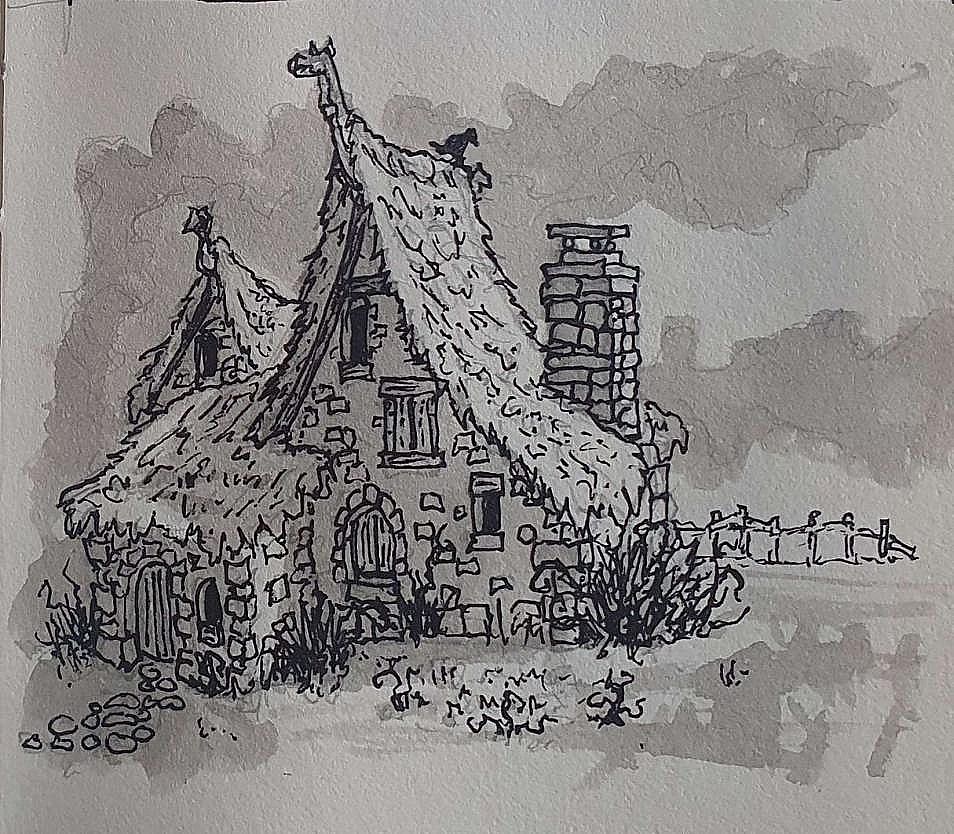
The Needle
A double row of cramped and claustrophobic shops and houses, piled up onto one-another with crooked walls and wonky rooftops. Most back onto a single narrow alleyway that ends in a warren of twists and turns. Even while shrouded in murky twilight gloom, large scorch marks can be made out on the walls and on the ground.
- A rusted contraption resembling a torturer's chair stands in the corner of a musty building with peeling paint. A tray full of small, vicious-looking tools (variously pointed, serrated, grasping or multi-jointed) stands on a table nearby. The smell of damp wood and stagnant water lingers in the air, mixed with a pungent scent of herbs. The crooked sign swinging over the doorway is faded but a painting of a tooth is still visible.
- The wooden plaque above the entrance to a small dilapidated round hut reads, "Seer of Truth. Teller of Lies." The interior is dominated by a rotted purple velvet drapery that cascades from floor to ceiling, wrapping the room in a musty fabric cocoon. A crystal ball perched atop a battered wooden table, reflecting a light that seems to have no source. Sitting behind the table is the dusty skeleton of a wizened old woman in a threadbare shawl, a gnarled hand, still open awaiting payment.
- The Fallen Goat , inn. The common room inside is dominated by a mammoth stuffed goat head, hanging upside-down, its glass eyes gleaming malevolently above the bar.
- The Last Batch . A large bakery with a tall stone chimney at the rear. Inside there is a huge stone oven with an iron door. A storeroom full of barrels of spoiled flour and dried fruit smells terrible. Wooden racks line the walls, around rows of work benches, occupy most of the remaining space.
Burrows
The streets of this ward are even more narrow and twisty than its neighbours, and congested by hard-packed snow, piled high on either side. They are permanently enveloped in deep shadows. They could easily become a death-trap for unsuspecting explorers… or attackers.
- Beneath the ward a number of interconnected caverns were cut-off from the surface when the island was frozen. Even as the Everwinter raged above them, the caverns remained warm and damp. Over time the flora and fauna that thrived there mutated and grew into forms not seen elsewhere in Ulgu, all living within a forest of strange lichen. And now, with the city thawing, things are beginning to get out…

Dregtorg
A run-down ward that was the black market. Many of the hovels have heavy reinforced doors and barred windows. There is very little ornamentation on the sheer, smooth stone walls. The streets are perpetually shrouded in a thick fog that obscures vision beyond a few paces.
- The Red Chalice, inn. A three-story wooden inn that looks almost out of place among the surrounding warehouses. The bright paintwork is faded and peeling but still very different to the buildings around it. The fireplace is in the centre of the common room and shaped like a large bowl or cup.
- A hideout is located in the basement of an old apothecary, accessed through a hidden entrance in the alley at the back. The air is thick with the smell of old books and burned herbs, with a small fireplace in the corner casting. Dozens of non-concentric circles have been drawn on the stone floor in chalk.
- The Black Sword , tavern. A two-story building with a sloping roof and boarded-up windows. The air inside is thick with salt and stale sweat and strong drink. Above the hearth hangs a wooden plaque with the silhouette of a missing longsword clearly visible in the discoloured varnish, and an ornately etched name plate. The bedrooms have no furniture.
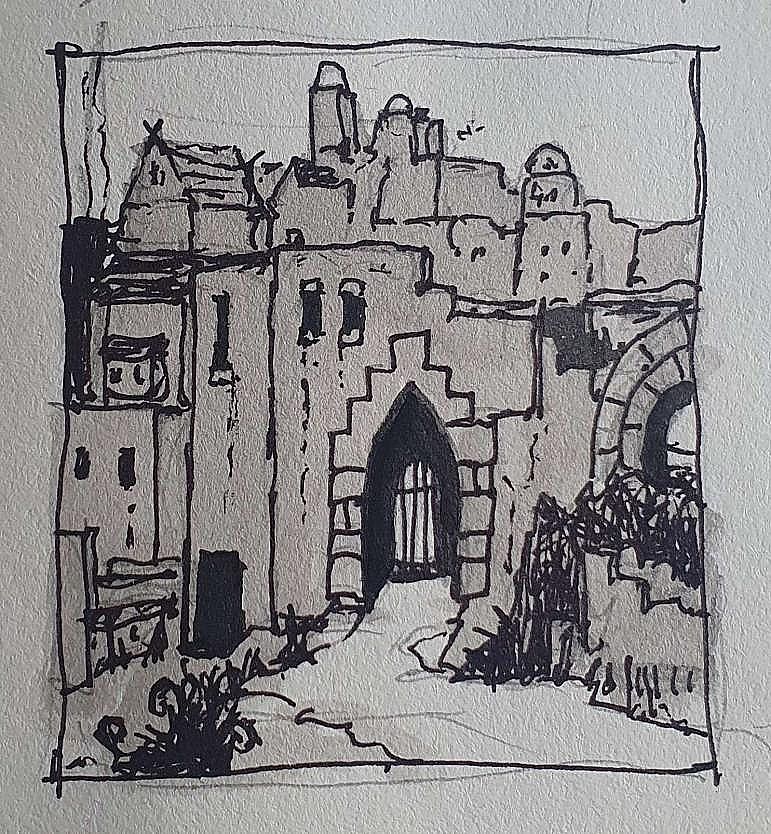
Ironthorn
 The alleyways are lined with empty storefronts and abandoned houses, the cobbled paths broken and uneven. Many of the buildings look like they are on the brink of collapse and some have passed that point long ago. Sagging roofs and precariously leaning walls are commonplace.
The alleyways are lined with empty storefronts and abandoned houses, the cobbled paths broken and uneven. Many of the buildings look like they are on the brink of collapse and some have passed that point long ago. Sagging roofs and precariously leaning walls are commonplace.
- A faint odour of blood and decay wafts from a nearby abattoir, giving the air an acrid metallic taste and an unnerving atmosphere of desolation. Behind the locked doors and featureless walls the work-hall is awash with stinking foetid carcases.
- The small workshop of a candlemaker looks like it was still in use when the city was frozen, the tools are still arranged in an ordered and neat way. The vats of wax are still full, if cold and solidified. But there is something very wrong about the candle wax.
- The Wailing Rider , inn. A large, rusted bell hangs above the entrance of a low timber building. Above the large fireplace the stonework of the chimney is carved into a galloping horse with a cloaked skeleton rider.
The Shroud
The ward at the foot of Eidolon Hill, below Okkam’s Tower. Snow and ice cover everything, making the ground treacherous and gouging at the buildings. An unlucky cluster of workshops and trinket sellers, who eked-out a meagre living supplying the sorcerous residents of the hilltop tower.
- A large house in the centre of the south-eastern edge of The Shroud gives the ward its name. The house is hard to look at, as it is entirely cloaked in darkness; it is as if the stone it's built from is made of solidified shadows. Blacker than black, it appears to be a hole in the realm. The direction from which it is viewed does not seem to matter; the building always looks like a silhouette. There are no visible doors or windows and even touching it is uncomfortable.
- An alchemist's workshop in a four-story stone building, with icicles hanging from the eaves and snowdrifts piled high around it. A pungent smell of vinegar mixed with old books emanates from within. A sign above the door reads "Philemon's Potions & Elixirs - Closed Until Further Notice." Through the dusty windows, a cold cauldron can be seen surrounded by various mysterious ingredients and a dead rat on the floor.
Wesgard (Battle Site 3)
The road turns back on itself several times as it climbs the steep hill toward Wesgard, the gatehouse of Dalrach Castle. Inside the walls are several rows of stone-and-timber barracks and stables, but the massive gatehouse and thick curtain wall bars the way.
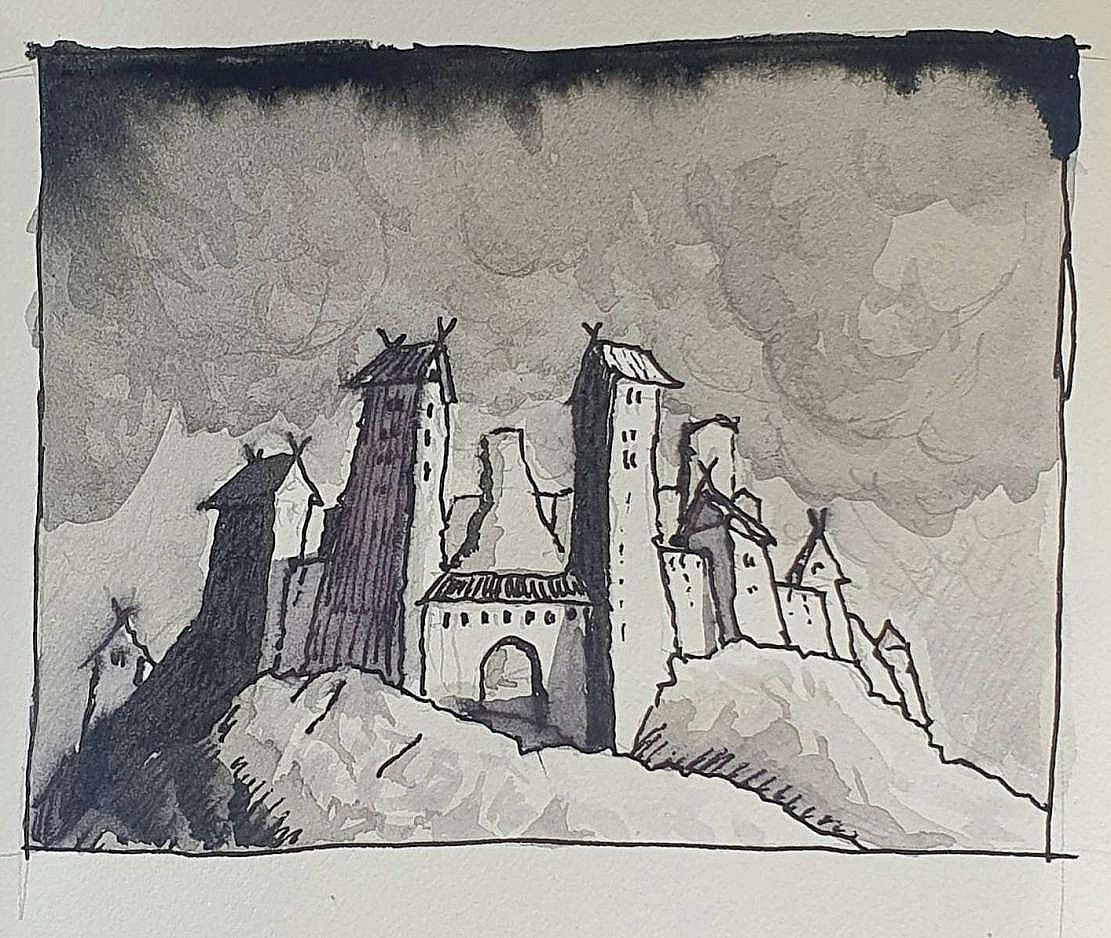
Dalrach Castle
The castle-keep stands at the summit of Brokk Fell, the island's highest peak, looming over the land below with its ancient stone walls and towering spires; stone-carved beasts adorning every corner. Even though a freezing cold wind whistles through the courtyards and corridors, the thick grey-green stones feel slightly warm to the touch. Strange symbols etched into the walls speak of an otherworldly power at play.
Maps from previous turns:
Turn 0
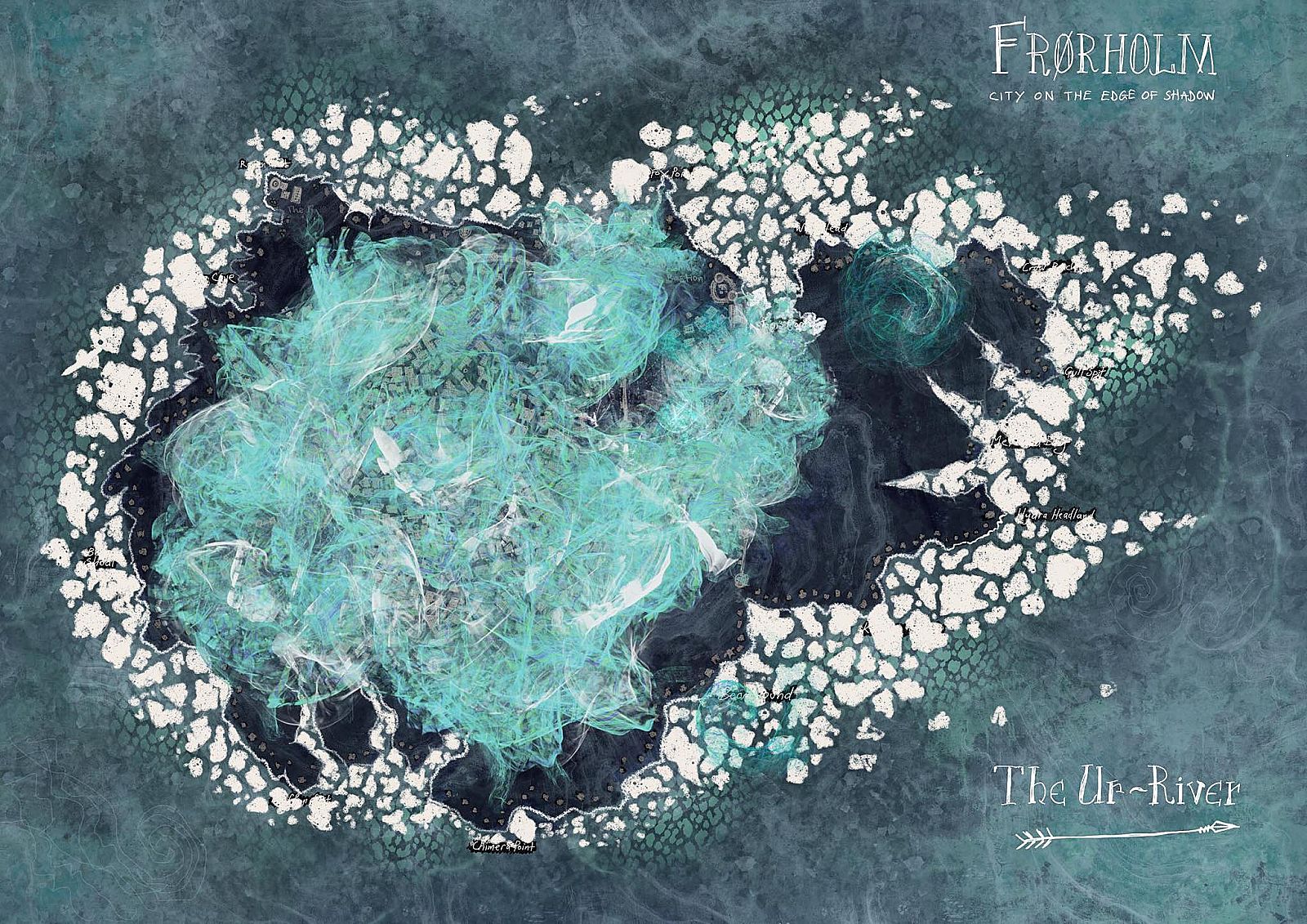
Turn 1
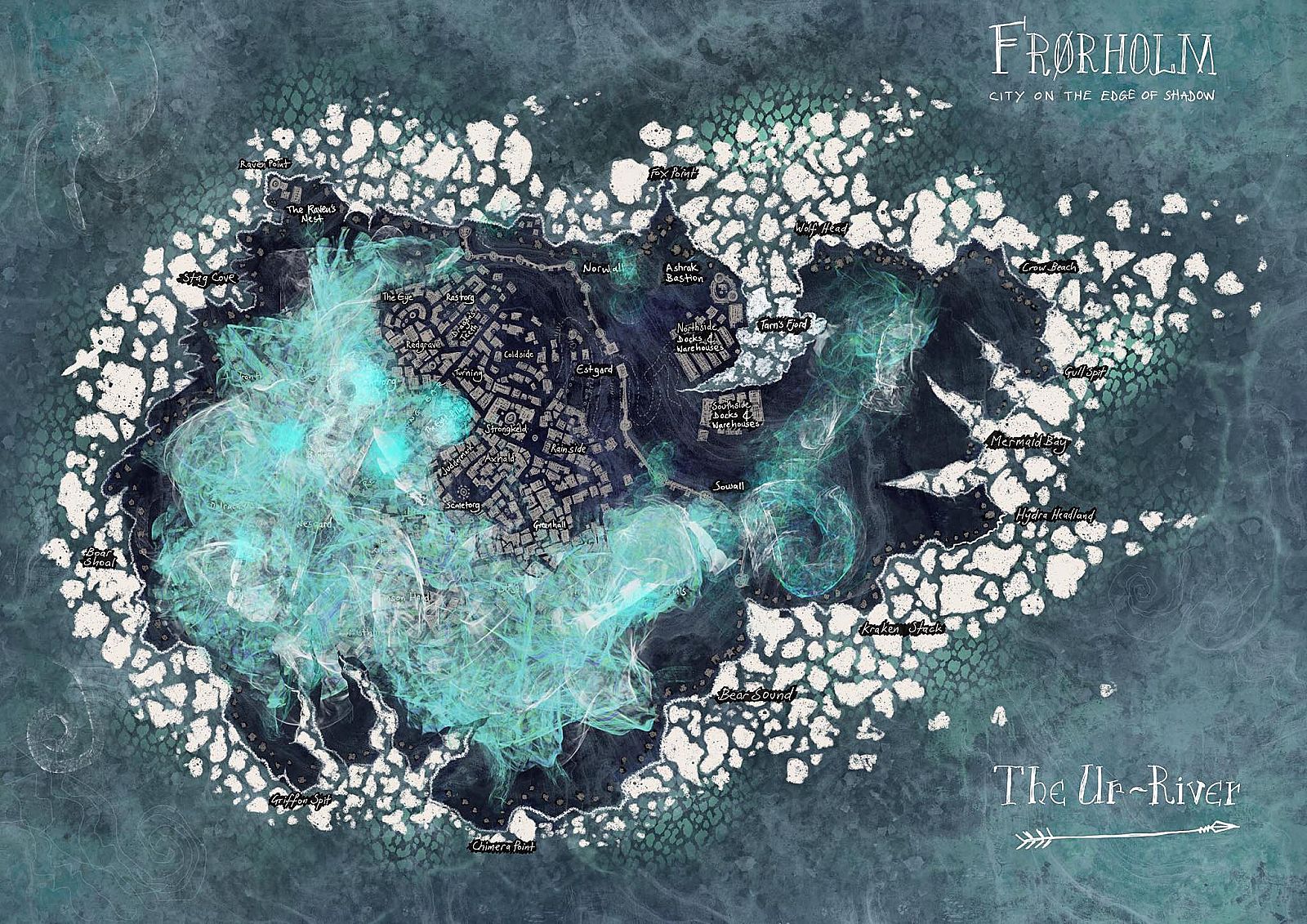
Turn 2
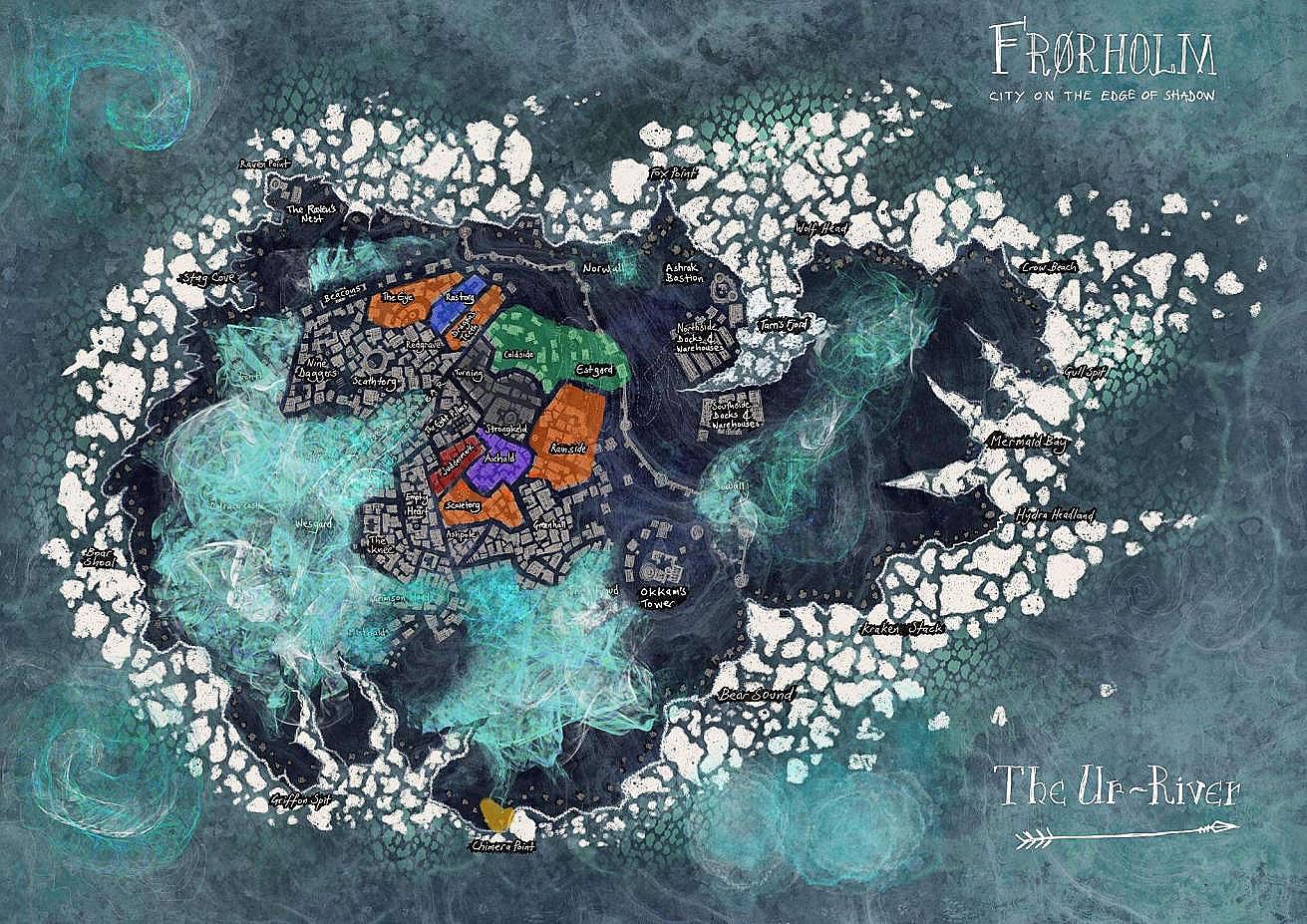
Turn 3

Turn 4

Turn 5

The "clean" map without campaign updates:

